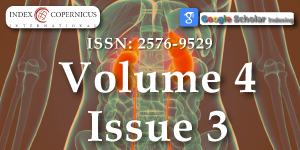Frequency of renal tubular acidosis in children with down syndrome
Main Article Content
Abstract
Background: Down syndrome (DS) is associated with various congenital diseases and malformations, including those of the kidneys and urinary tract. It has been thought that renal tubular acidosis (RTA) is more frequent in this population. The objective of this study was to assess the frequency of RTA and, secondarily, of other renal and urological disorders in persons with DS.
Method: An observational, ambispective, descriptive and cross-sectional study of patients diagnosed with RTA, or suspected kidney or urological disorders, was carried out from July 2016 to September 2017 at the Down syndrome clinic of the Mexican National Institute of Paediatrics. Urinalysis was performed, along with analyses of venous blood gas, sodium, potassium, chlorine, calcium, phosphorus, albumin and creatinine. Those with any abnormal values were referred to nephrology for diagnostic evaluation.
Results: Of a total of 700 patients seen at the clinic, 47 met the selection criteria. Of these, 32 had no RTA or other renal or urological alterations. The remaining 15 continued to the second phase of the study, where 6 were diagnosed with nephropathy or uropathy (RTA, systemic arterial hypertension, monosymptomatic familial haematuria, mild renal failure secondary to reflux nephropathy, urinary tract infection or right ureteropelvic stenosis). Four had mild metabolic acidosis without meeting the criteria for diagnosis of RTA.
Conclusion: RTA is not more common in children with Down syndrome. Nephropathies and uropathies should be investigated in the evaluation of DS patients.
Article Details
Copyright (c) 2020 de la Puente SG, et al.

This work is licensed under a Creative Commons Attribution 4.0 International License.
The Journal of Clinical Nephrology is committed in making it easier for people to share and build upon the work of others while maintaining consistency with the rules of copyright. In order to use the Open Access paradigm to the maximum extent in true terms as free of charge online access along with usage right, we grant usage rights through the use of specific Creative Commons license.
License: Copyright © 2017 - 2025 |  Open Access by Journal of Clinical Nephrology is licensed under a Creative Commons Attribution 4.0 International License. Based on a work at Heighten Science Publications Inc.
Open Access by Journal of Clinical Nephrology is licensed under a Creative Commons Attribution 4.0 International License. Based on a work at Heighten Science Publications Inc.
With this license, the authors are allowed that after publishing with the journal, they can share their research by posting a free draft copy of their article to any repository or website.
Compliance 'CC BY' license helps in:
| Permission to read and download | ✓ |
| Permission to display in a repository | ✓ |
| Permission to translate | ✓ |
| Commercial uses of manuscript | ✓ |
'CC' stands for Creative Commons license. 'BY' symbolizes that users have provided attribution to the creator that the published manuscripts can be used or shared. This license allows for redistribution, commercial and non-commercial, as long as it is passed along unchanged and in whole, with credit to the author.
Please take in notification that Creative Commons user licenses are non-revocable. We recommend authors to check if their funding body requires a specific license.
Parker SE, Mai CT, Canfield MA, Rickard R, Wang Y, et al. Updated national birth prevalence estimates for selected birth defects in the United States, 2004-2006. Birth Defects Res Part A - Clin Mol Teratol. 2010; 88: 1008–1016. PubMed: https://pubmed.ncbi.nlm.nih.gov/20878909/
Asim A, Kumar A, Muthuswamy S, Jain S, Agarwal S. Down syndrome: an insight of the disease. J Biomed Sci. 2015; 22: 41. http://www.jbiomedsci.com/content/22/1/41
Kupferman JC, Druschel CM, Kupchik GS. Increased prevalence of renal and urinary tract anomalies in children with Down syndrome. Pediatrics. 2009;124: e615-621. PubMed: https://pubmed.ncbi.nlm.nih.gov/19752083/
Fitz Simmons J, Droste S, Shepard TH, Pascoe-Mason J, Chinn A, et al. Long-bone growth in fetuses with Down syndrome. Am J Obstet Gynecol. 1989; 161: 1174–1477. PubMed: https://pubmed.ncbi.nlm.nih.gov/2531547/
Rocha-Gómez MI, Zaltzman-Girshëvich S, García-De La Puente S. Utilidad de la recolección de orina de dos horas para el diagnóstico del tipo de acidosis tubular renal. Acta Pediatr Mex. 2015; 36: 322–329.
Alexander RT, Bitzan M. Pediatr Clin North Am. 2019; 66: 135-157.
García de la Puente S. Acidosis tubular renal. Acta Pediatr. 2006; 27: 268-278. www.revistasmedicas.com.mx
Guizar JM, Kornhauser C, Malacara JM, Sanchez G, Zamora J. Renal tubular acidosis in children with vesicoureteral reflux. J Urol. 2019; 156: 193–195. PubMed: http://www.ncbi.nlm.nih.gov/pubmed/8648800
Kupferman JC, Stewart CL, Kaskel FJ, Fine RN. Posterior urethral valves in patients with Down syndrome. Pediatr Nephrol. 1996; 10: 143–146. PubMed: https://pubmed.ncbi.nlm.nih.gov/8703697/
Jain M, Singh A, Mantan M, Kapoor S. Evaluation of structural anomalies of kidney and urinary tract in children with down syndrome. Indian J Pediatr. 2014; 81: 73.
Málaga S, Pardo R, Málaga I, Orejas G, Fernández-Toral J. Renal involvement in Down syndrome. Pediatr Nephrol. 2005; 20: 614–617. PubMed: https://pubmed.ncbi.nlm.nih.gov/15785939/
Mercer ES, Broecker B, Smith EA, Kirsch AJ, Scherz HC, et al. Urological manifestations of Down syndrome. Vol. 171, Journal of Urology. Lippincott Williams and Wilkins; 2004: 1250–1253. PubMed: https://pubmed.ncbi.nlm.nih.gov/14767322/
Ariel I, Wells TR, Landing BH, Singer DB. The urinary system in down syndrome: A study of 124 autopsy cases. Fetal Pediatr Pathol. 1991; 11: 879–888. PubMed: https://pubmed.ncbi.nlm.nih.gov/1837925/
Lo A, Brown HG, Fivush BA, Neu AM, Racusen LC. Renal disease in Down syndrome: Autopsy study with emphasis on glomerular lesions. Am J Kidney Dis. 1998; 31: 329–335. PubMed: https://pubmed.ncbi.nlm.nih.gov/9469506/
Yamakawa S, Nagai T, Uemura O. Down syndrome and mild kidney dysfunction. Pediatr Int. 2019; 60: 391–393.

